E-Cigarette Effectiveness in Smoking Cessation: A Comprehensive Report
VerifiedAdded on 2023/06/04
|8
|2002
|380
Report
AI Summary
This report critically analyzes the effectiveness of e-cigarettes as a smoking cessation tool, drawing upon evidence-based research and case studies. The introduction establishes the need for a rigorous evaluation of e-cigarette efficacy, referencing relevant studies to address the clinical question of how e-cigarettes compare to other therapies like nicotine replacement therapy (NRT). The report assesses the strengths and limitations of the research, including the use of large samples, the emergence of e-cigarettes as a therapy, and the reliance on self-reported data. It examines research questions, designs, and methods, highlighting the use of cross-sectional surveys and ANOVA analysis. Findings suggest that e-cigarettes can be effective for some smokers, but the report also acknowledges limitations, such as the lack of clinical guidelines and potential health implications. The conclusion emphasizes the need for further research and cautions against using the current evidence to inform clinical practice without considering a combination of methods to aid in quitting smoking. The report is based on a case study and provides recommendations and insights into the role of e-cigarettes in smoking cessation.
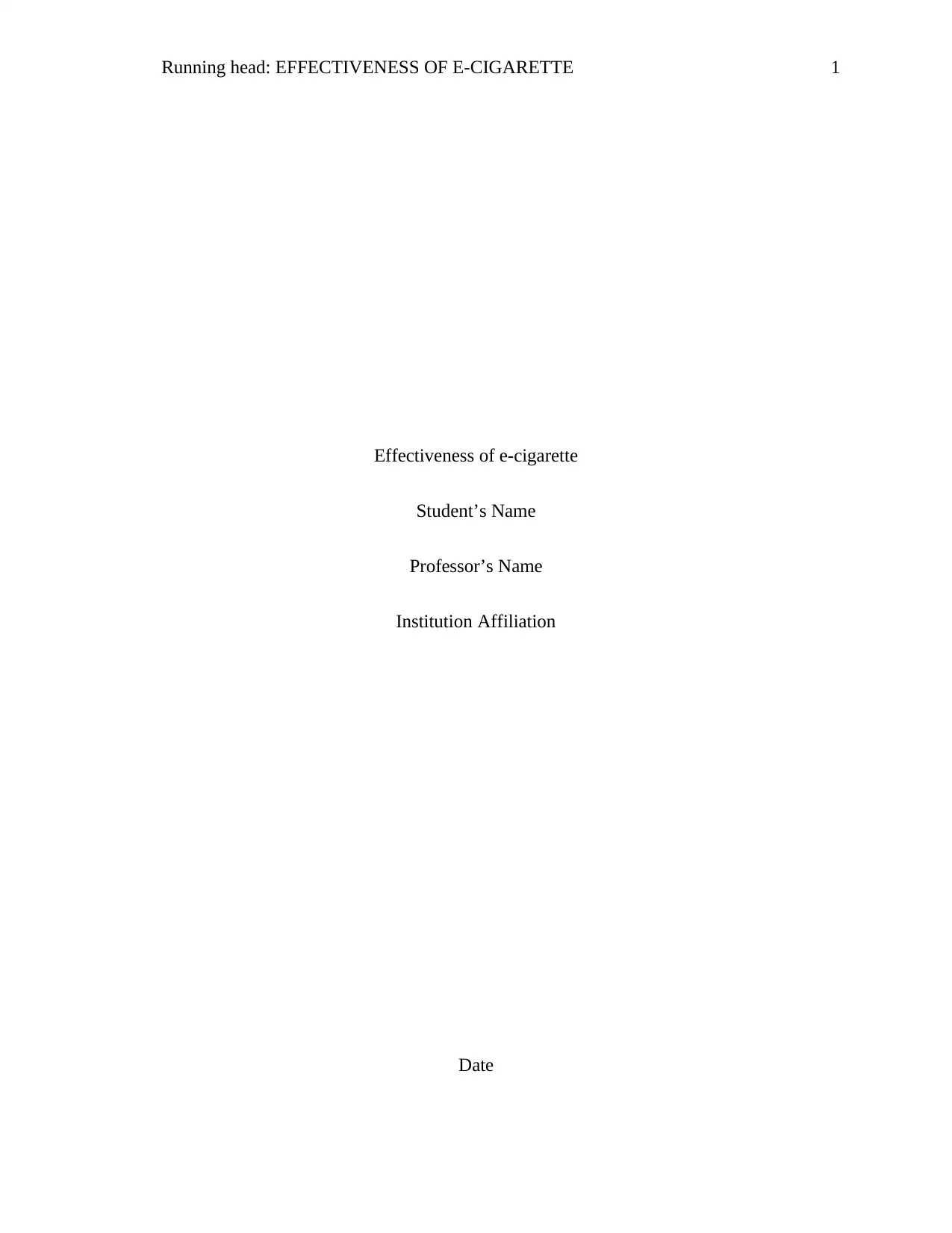
Running head: EFFECTIVENESS OF E-CIGARETTE 1
Effectiveness of e-cigarette
Student’s Name
Professor’s Name
Institution Affiliation
Date
Effectiveness of e-cigarette
Student’s Name
Professor’s Name
Institution Affiliation
Date
Paraphrase This Document
Need a fresh take? Get an instant paraphrase of this document with our AI Paraphraser
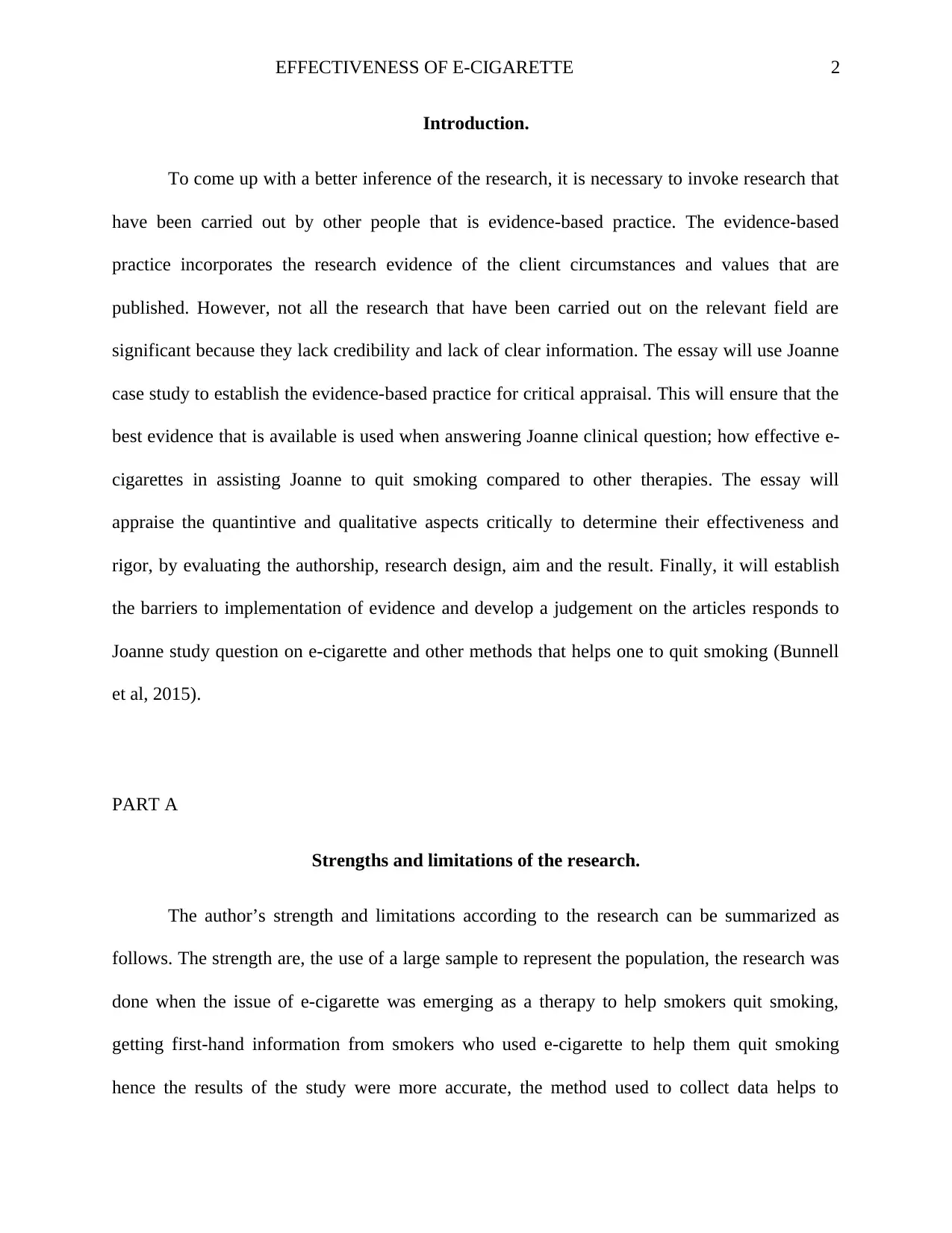
EFFECTIVENESS OF E-CIGARETTE 2
Introduction.
To come up with a better inference of the research, it is necessary to invoke research that
have been carried out by other people that is evidence-based practice. The evidence-based
practice incorporates the research evidence of the client circumstances and values that are
published. However, not all the research that have been carried out on the relevant field are
significant because they lack credibility and lack of clear information. The essay will use Joanne
case study to establish the evidence-based practice for critical appraisal. This will ensure that the
best evidence that is available is used when answering Joanne clinical question; how effective e-
cigarettes in assisting Joanne to quit smoking compared to other therapies. The essay will
appraise the quantintive and qualitative aspects critically to determine their effectiveness and
rigor, by evaluating the authorship, research design, aim and the result. Finally, it will establish
the barriers to implementation of evidence and develop a judgement on the articles responds to
Joanne study question on e-cigarette and other methods that helps one to quit smoking (Bunnell
et al, 2015).
PART A
Strengths and limitations of the research.
The author’s strength and limitations according to the research can be summarized as
follows. The strength are, the use of a large sample to represent the population, the research was
done when the issue of e-cigarette was emerging as a therapy to help smokers quit smoking,
getting first-hand information from smokers who used e-cigarette to help them quit smoking
hence the results of the study were more accurate, the method used to collect data helps to
Introduction.
To come up with a better inference of the research, it is necessary to invoke research that
have been carried out by other people that is evidence-based practice. The evidence-based
practice incorporates the research evidence of the client circumstances and values that are
published. However, not all the research that have been carried out on the relevant field are
significant because they lack credibility and lack of clear information. The essay will use Joanne
case study to establish the evidence-based practice for critical appraisal. This will ensure that the
best evidence that is available is used when answering Joanne clinical question; how effective e-
cigarettes in assisting Joanne to quit smoking compared to other therapies. The essay will
appraise the quantintive and qualitative aspects critically to determine their effectiveness and
rigor, by evaluating the authorship, research design, aim and the result. Finally, it will establish
the barriers to implementation of evidence and develop a judgement on the articles responds to
Joanne study question on e-cigarette and other methods that helps one to quit smoking (Bunnell
et al, 2015).
PART A
Strengths and limitations of the research.
The author’s strength and limitations according to the research can be summarized as
follows. The strength are, the use of a large sample to represent the population, the research was
done when the issue of e-cigarette was emerging as a therapy to help smokers quit smoking,
getting first-hand information from smokers who used e-cigarette to help them quit smoking
hence the results of the study were more accurate, the method used to collect data helps to
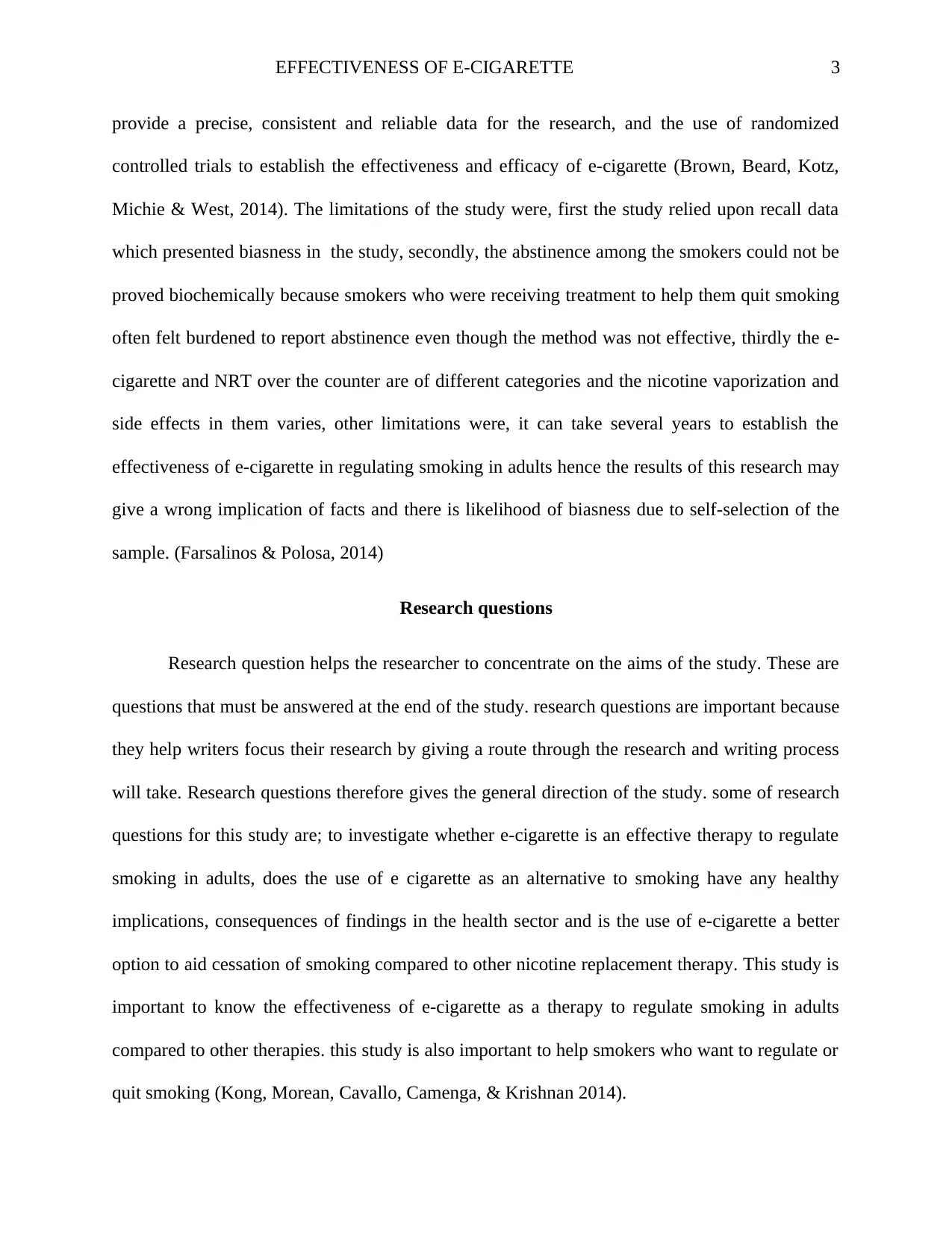
EFFECTIVENESS OF E-CIGARETTE 3
provide a precise, consistent and reliable data for the research, and the use of randomized
controlled trials to establish the effectiveness and efficacy of e-cigarette (Brown, Beard, Kotz,
Michie & West, 2014). The limitations of the study were, first the study relied upon recall data
which presented biasness in the study, secondly, the abstinence among the smokers could not be
proved biochemically because smokers who were receiving treatment to help them quit smoking
often felt burdened to report abstinence even though the method was not effective, thirdly the e-
cigarette and NRT over the counter are of different categories and the nicotine vaporization and
side effects in them varies, other limitations were, it can take several years to establish the
effectiveness of e-cigarette in regulating smoking in adults hence the results of this research may
give a wrong implication of facts and there is likelihood of biasness due to self-selection of the
sample. (Farsalinos & Polosa, 2014)
Research questions
Research question helps the researcher to concentrate on the aims of the study. These are
questions that must be answered at the end of the study. research questions are important because
they help writers focus their research by giving a route through the research and writing process
will take. Research questions therefore gives the general direction of the study. some of research
questions for this study are; to investigate whether e-cigarette is an effective therapy to regulate
smoking in adults, does the use of e cigarette as an alternative to smoking have any healthy
implications, consequences of findings in the health sector and is the use of e-cigarette a better
option to aid cessation of smoking compared to other nicotine replacement therapy. This study is
important to know the effectiveness of e-cigarette as a therapy to regulate smoking in adults
compared to other therapies. this study is also important to help smokers who want to regulate or
quit smoking (Kong, Morean, Cavallo, Camenga, & Krishnan 2014).
provide a precise, consistent and reliable data for the research, and the use of randomized
controlled trials to establish the effectiveness and efficacy of e-cigarette (Brown, Beard, Kotz,
Michie & West, 2014). The limitations of the study were, first the study relied upon recall data
which presented biasness in the study, secondly, the abstinence among the smokers could not be
proved biochemically because smokers who were receiving treatment to help them quit smoking
often felt burdened to report abstinence even though the method was not effective, thirdly the e-
cigarette and NRT over the counter are of different categories and the nicotine vaporization and
side effects in them varies, other limitations were, it can take several years to establish the
effectiveness of e-cigarette in regulating smoking in adults hence the results of this research may
give a wrong implication of facts and there is likelihood of biasness due to self-selection of the
sample. (Farsalinos & Polosa, 2014)
Research questions
Research question helps the researcher to concentrate on the aims of the study. These are
questions that must be answered at the end of the study. research questions are important because
they help writers focus their research by giving a route through the research and writing process
will take. Research questions therefore gives the general direction of the study. some of research
questions for this study are; to investigate whether e-cigarette is an effective therapy to regulate
smoking in adults, does the use of e cigarette as an alternative to smoking have any healthy
implications, consequences of findings in the health sector and is the use of e-cigarette a better
option to aid cessation of smoking compared to other nicotine replacement therapy. This study is
important to know the effectiveness of e-cigarette as a therapy to regulate smoking in adults
compared to other therapies. this study is also important to help smokers who want to regulate or
quit smoking (Kong, Morean, Cavallo, Camenga, & Krishnan 2014).
⊘ This is a preview!⊘
Do you want full access?
Subscribe today to unlock all pages.

Trusted by 1+ million students worldwide
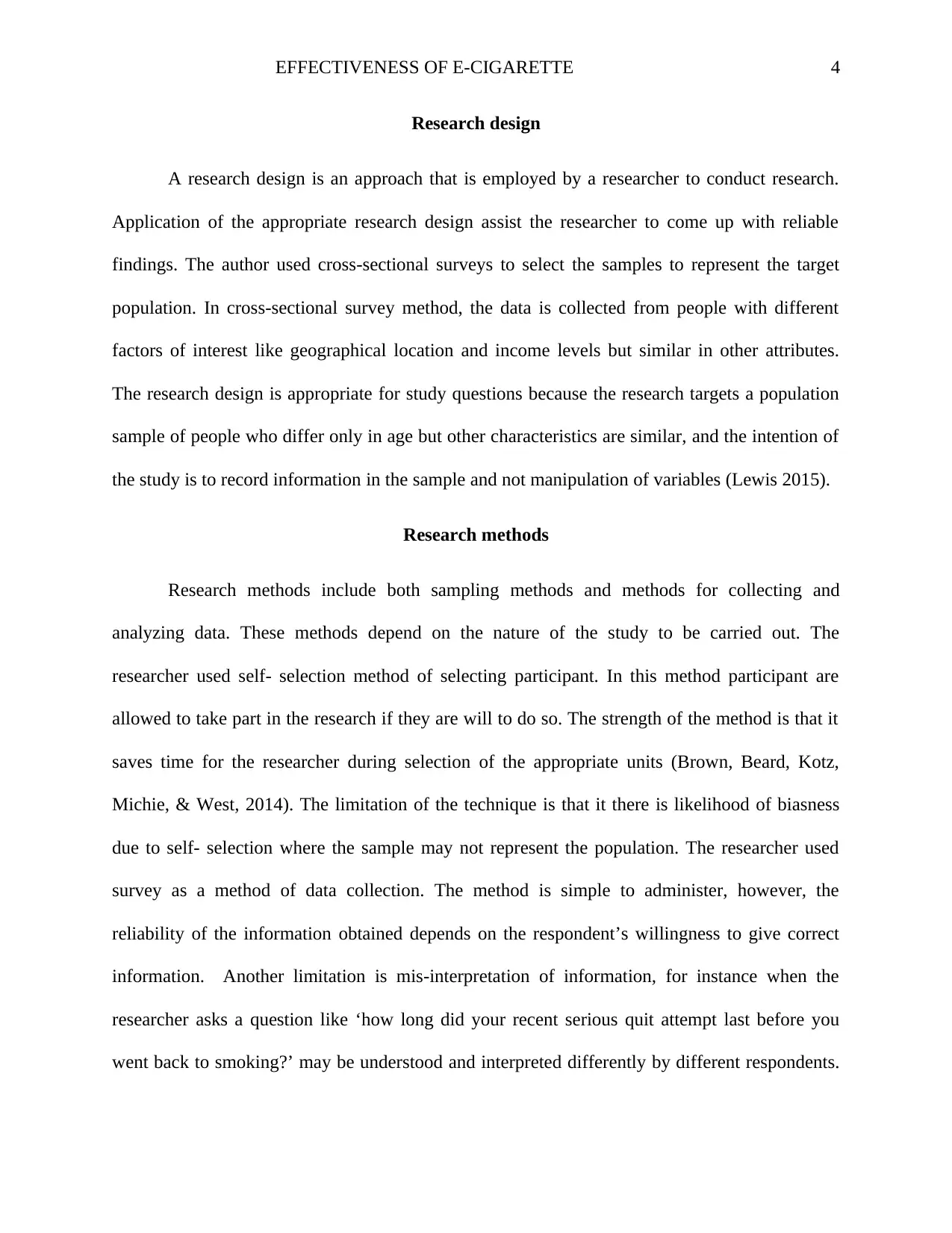
EFFECTIVENESS OF E-CIGARETTE 4
Research design
A research design is an approach that is employed by a researcher to conduct research.
Application of the appropriate research design assist the researcher to come up with reliable
findings. The author used cross-sectional surveys to select the samples to represent the target
population. In cross-sectional survey method, the data is collected from people with different
factors of interest like geographical location and income levels but similar in other attributes.
The research design is appropriate for study questions because the research targets a population
sample of people who differ only in age but other characteristics are similar, and the intention of
the study is to record information in the sample and not manipulation of variables (Lewis 2015).
Research methods
Research methods include both sampling methods and methods for collecting and
analyzing data. These methods depend on the nature of the study to be carried out. The
researcher used self- selection method of selecting participant. In this method participant are
allowed to take part in the research if they are will to do so. The strength of the method is that it
saves time for the researcher during selection of the appropriate units (Brown, Beard, Kotz,
Michie, & West, 2014). The limitation of the technique is that it there is likelihood of biasness
due to self- selection where the sample may not represent the population. The researcher used
survey as a method of data collection. The method is simple to administer, however, the
reliability of the information obtained depends on the respondent’s willingness to give correct
information. Another limitation is mis-interpretation of information, for instance when the
researcher asks a question like ‘how long did your recent serious quit attempt last before you
went back to smoking?’ may be understood and interpreted differently by different respondents.
Research design
A research design is an approach that is employed by a researcher to conduct research.
Application of the appropriate research design assist the researcher to come up with reliable
findings. The author used cross-sectional surveys to select the samples to represent the target
population. In cross-sectional survey method, the data is collected from people with different
factors of interest like geographical location and income levels but similar in other attributes.
The research design is appropriate for study questions because the research targets a population
sample of people who differ only in age but other characteristics are similar, and the intention of
the study is to record information in the sample and not manipulation of variables (Lewis 2015).
Research methods
Research methods include both sampling methods and methods for collecting and
analyzing data. These methods depend on the nature of the study to be carried out. The
researcher used self- selection method of selecting participant. In this method participant are
allowed to take part in the research if they are will to do so. The strength of the method is that it
saves time for the researcher during selection of the appropriate units (Brown, Beard, Kotz,
Michie, & West, 2014). The limitation of the technique is that it there is likelihood of biasness
due to self- selection where the sample may not represent the population. The researcher used
survey as a method of data collection. The method is simple to administer, however, the
reliability of the information obtained depends on the respondent’s willingness to give correct
information. Another limitation is mis-interpretation of information, for instance when the
researcher asks a question like ‘how long did your recent serious quit attempt last before you
went back to smoking?’ may be understood and interpreted differently by different respondents.
Paraphrase This Document
Need a fresh take? Get an instant paraphrase of this document with our AI Paraphraser
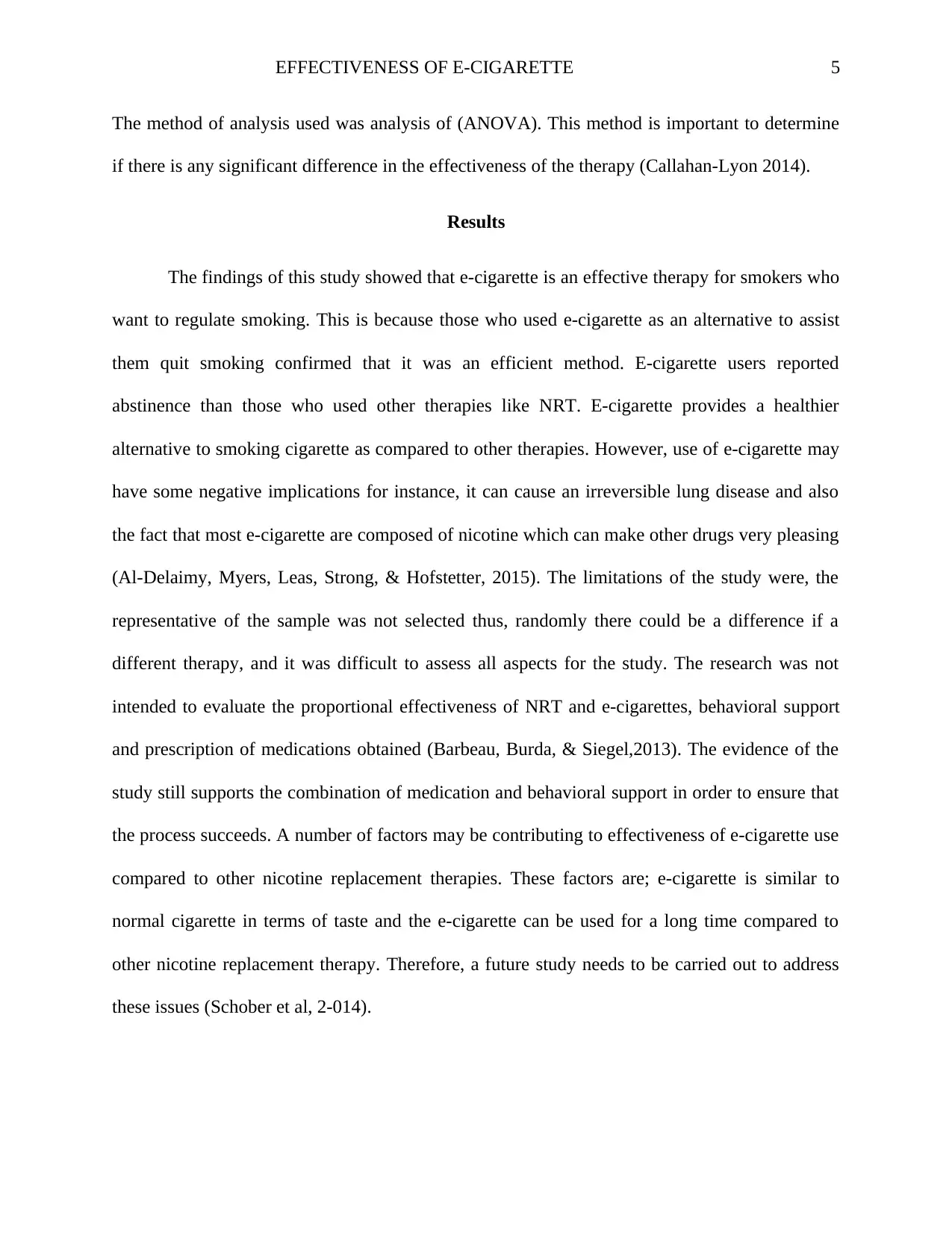
EFFECTIVENESS OF E-CIGARETTE 5
The method of analysis used was analysis of (ANOVA). This method is important to determine
if there is any significant difference in the effectiveness of the therapy (Callahan-Lyon 2014).
Results
The findings of this study showed that e-cigarette is an effective therapy for smokers who
want to regulate smoking. This is because those who used e-cigarette as an alternative to assist
them quit smoking confirmed that it was an efficient method. E-cigarette users reported
abstinence than those who used other therapies like NRT. E-cigarette provides a healthier
alternative to smoking cigarette as compared to other therapies. However, use of e-cigarette may
have some negative implications for instance, it can cause an irreversible lung disease and also
the fact that most e-cigarette are composed of nicotine which can make other drugs very pleasing
(Al-Delaimy, Myers, Leas, Strong, & Hofstetter, 2015). The limitations of the study were, the
representative of the sample was not selected thus, randomly there could be a difference if a
different therapy, and it was difficult to assess all aspects for the study. The research was not
intended to evaluate the proportional effectiveness of NRT and e-cigarettes, behavioral support
and prescription of medications obtained (Barbeau, Burda, & Siegel,2013). The evidence of the
study still supports the combination of medication and behavioral support in order to ensure that
the process succeeds. A number of factors may be contributing to effectiveness of e-cigarette use
compared to other nicotine replacement therapies. These factors are; e-cigarette is similar to
normal cigarette in terms of taste and the e-cigarette can be used for a long time compared to
other nicotine replacement therapy. Therefore, a future study needs to be carried out to address
these issues (Schober et al, 2-014).
The method of analysis used was analysis of (ANOVA). This method is important to determine
if there is any significant difference in the effectiveness of the therapy (Callahan-Lyon 2014).
Results
The findings of this study showed that e-cigarette is an effective therapy for smokers who
want to regulate smoking. This is because those who used e-cigarette as an alternative to assist
them quit smoking confirmed that it was an efficient method. E-cigarette users reported
abstinence than those who used other therapies like NRT. E-cigarette provides a healthier
alternative to smoking cigarette as compared to other therapies. However, use of e-cigarette may
have some negative implications for instance, it can cause an irreversible lung disease and also
the fact that most e-cigarette are composed of nicotine which can make other drugs very pleasing
(Al-Delaimy, Myers, Leas, Strong, & Hofstetter, 2015). The limitations of the study were, the
representative of the sample was not selected thus, randomly there could be a difference if a
different therapy, and it was difficult to assess all aspects for the study. The research was not
intended to evaluate the proportional effectiveness of NRT and e-cigarettes, behavioral support
and prescription of medications obtained (Barbeau, Burda, & Siegel,2013). The evidence of the
study still supports the combination of medication and behavioral support in order to ensure that
the process succeeds. A number of factors may be contributing to effectiveness of e-cigarette use
compared to other nicotine replacement therapies. These factors are; e-cigarette is similar to
normal cigarette in terms of taste and the e-cigarette can be used for a long time compared to
other nicotine replacement therapy. Therefore, a future study needs to be carried out to address
these issues (Schober et al, 2-014).
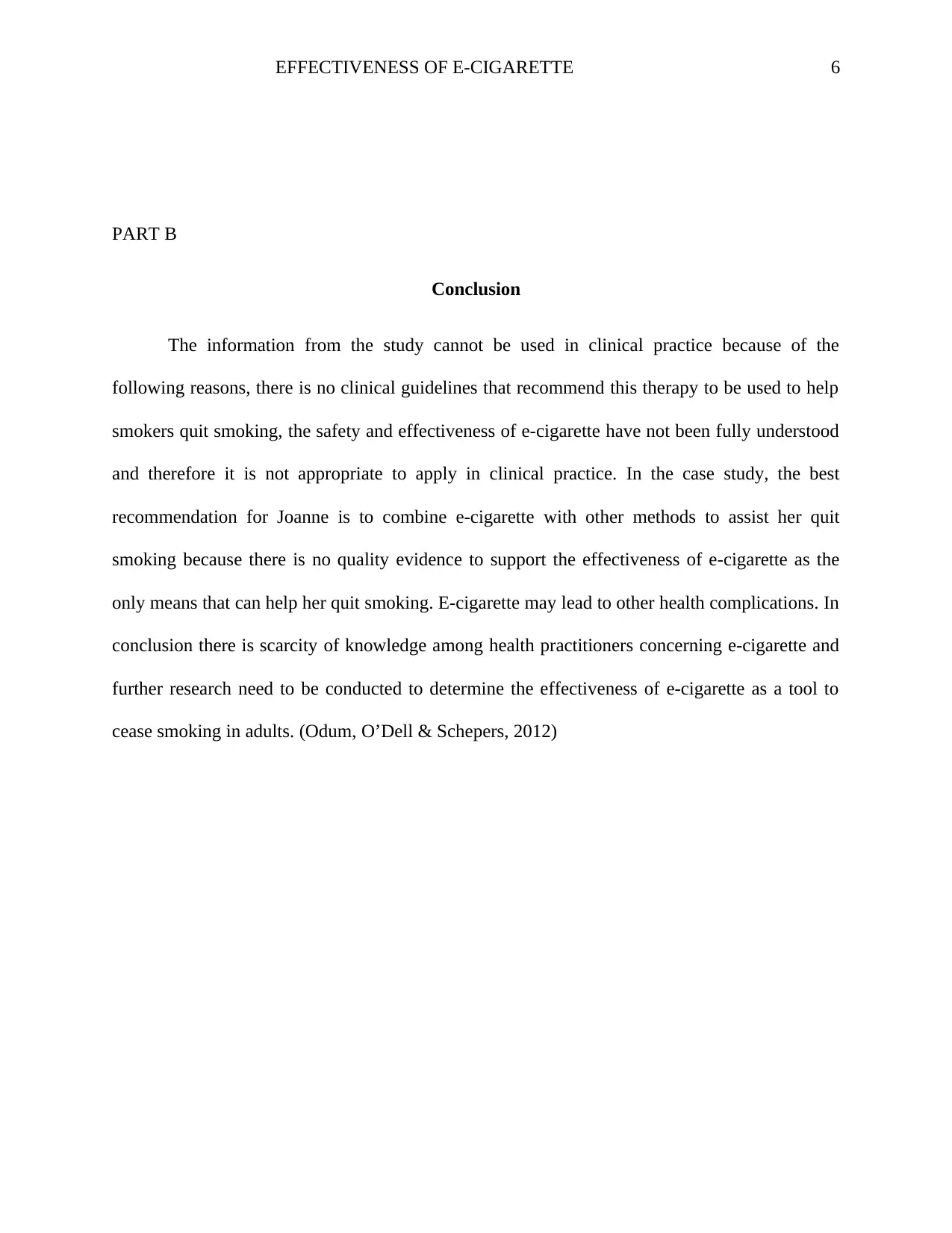
EFFECTIVENESS OF E-CIGARETTE 6
PART B
Conclusion
The information from the study cannot be used in clinical practice because of the
following reasons, there is no clinical guidelines that recommend this therapy to be used to help
smokers quit smoking, the safety and effectiveness of e-cigarette have not been fully understood
and therefore it is not appropriate to apply in clinical practice. In the case study, the best
recommendation for Joanne is to combine e-cigarette with other methods to assist her quit
smoking because there is no quality evidence to support the effectiveness of e-cigarette as the
only means that can help her quit smoking. E-cigarette may lead to other health complications. In
conclusion there is scarcity of knowledge among health practitioners concerning e-cigarette and
further research need to be conducted to determine the effectiveness of e-cigarette as a tool to
cease smoking in adults. (Odum, O’Dell & Schepers, 2012)
PART B
Conclusion
The information from the study cannot be used in clinical practice because of the
following reasons, there is no clinical guidelines that recommend this therapy to be used to help
smokers quit smoking, the safety and effectiveness of e-cigarette have not been fully understood
and therefore it is not appropriate to apply in clinical practice. In the case study, the best
recommendation for Joanne is to combine e-cigarette with other methods to assist her quit
smoking because there is no quality evidence to support the effectiveness of e-cigarette as the
only means that can help her quit smoking. E-cigarette may lead to other health complications. In
conclusion there is scarcity of knowledge among health practitioners concerning e-cigarette and
further research need to be conducted to determine the effectiveness of e-cigarette as a tool to
cease smoking in adults. (Odum, O’Dell & Schepers, 2012)
⊘ This is a preview!⊘
Do you want full access?
Subscribe today to unlock all pages.

Trusted by 1+ million students worldwide
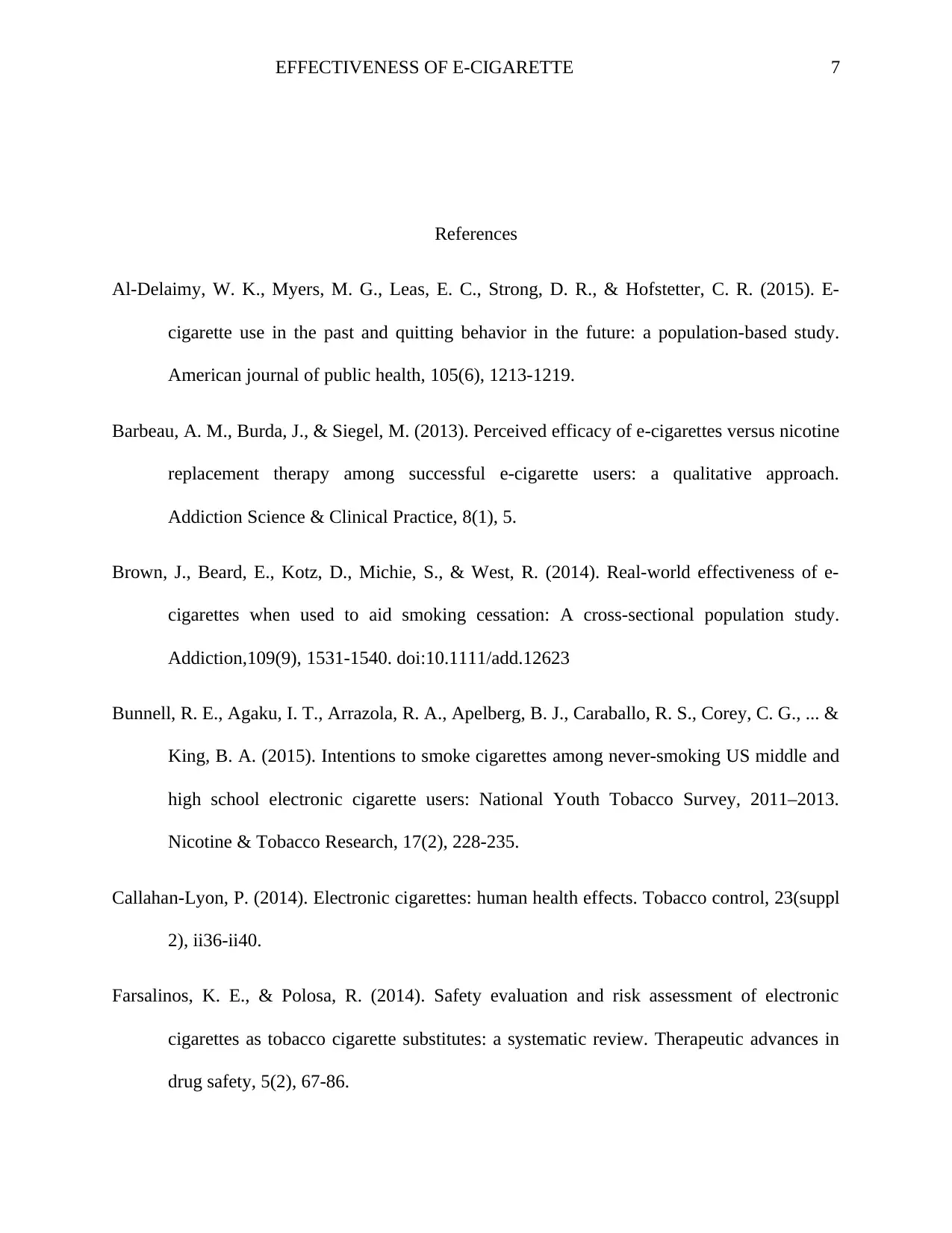
EFFECTIVENESS OF E-CIGARETTE 7
References
Al-Delaimy, W. K., Myers, M. G., Leas, E. C., Strong, D. R., & Hofstetter, C. R. (2015). E-
cigarette use in the past and quitting behavior in the future: a population-based study.
American journal of public health, 105(6), 1213-1219.
Barbeau, A. M., Burda, J., & Siegel, M. (2013). Perceived efficacy of e-cigarettes versus nicotine
replacement therapy among successful e-cigarette users: a qualitative approach.
Addiction Science & Clinical Practice, 8(1), 5.
Brown, J., Beard, E., Kotz, D., Michie, S., & West, R. (2014). Real-world effectiveness of e-
cigarettes when used to aid smoking cessation: A cross-sectional population study.
Addiction,109(9), 1531-1540. doi:10.1111/add.12623
Bunnell, R. E., Agaku, I. T., Arrazola, R. A., Apelberg, B. J., Caraballo, R. S., Corey, C. G., ... &
King, B. A. (2015). Intentions to smoke cigarettes among never-smoking US middle and
high school electronic cigarette users: National Youth Tobacco Survey, 2011–2013.
Nicotine & Tobacco Research, 17(2), 228-235.
Callahan-Lyon, P. (2014). Electronic cigarettes: human health effects. Tobacco control, 23(suppl
2), ii36-ii40.
Farsalinos, K. E., & Polosa, R. (2014). Safety evaluation and risk assessment of electronic
cigarettes as tobacco cigarette substitutes: a systematic review. Therapeutic advances in
drug safety, 5(2), 67-86.
References
Al-Delaimy, W. K., Myers, M. G., Leas, E. C., Strong, D. R., & Hofstetter, C. R. (2015). E-
cigarette use in the past and quitting behavior in the future: a population-based study.
American journal of public health, 105(6), 1213-1219.
Barbeau, A. M., Burda, J., & Siegel, M. (2013). Perceived efficacy of e-cigarettes versus nicotine
replacement therapy among successful e-cigarette users: a qualitative approach.
Addiction Science & Clinical Practice, 8(1), 5.
Brown, J., Beard, E., Kotz, D., Michie, S., & West, R. (2014). Real-world effectiveness of e-
cigarettes when used to aid smoking cessation: A cross-sectional population study.
Addiction,109(9), 1531-1540. doi:10.1111/add.12623
Bunnell, R. E., Agaku, I. T., Arrazola, R. A., Apelberg, B. J., Caraballo, R. S., Corey, C. G., ... &
King, B. A. (2015). Intentions to smoke cigarettes among never-smoking US middle and
high school electronic cigarette users: National Youth Tobacco Survey, 2011–2013.
Nicotine & Tobacco Research, 17(2), 228-235.
Callahan-Lyon, P. (2014). Electronic cigarettes: human health effects. Tobacco control, 23(suppl
2), ii36-ii40.
Farsalinos, K. E., & Polosa, R. (2014). Safety evaluation and risk assessment of electronic
cigarettes as tobacco cigarette substitutes: a systematic review. Therapeutic advances in
drug safety, 5(2), 67-86.
Paraphrase This Document
Need a fresh take? Get an instant paraphrase of this document with our AI Paraphraser
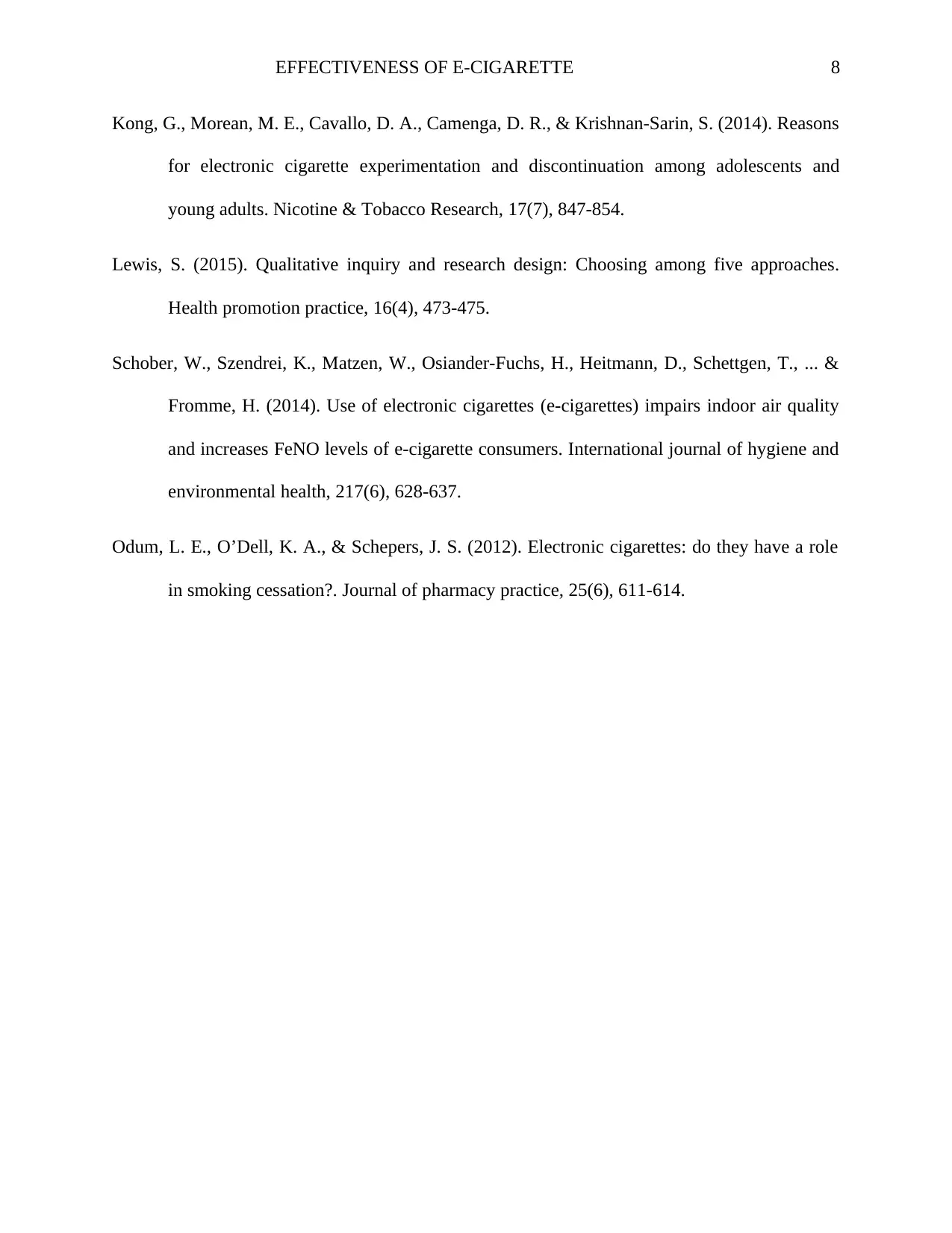
EFFECTIVENESS OF E-CIGARETTE 8
Kong, G., Morean, M. E., Cavallo, D. A., Camenga, D. R., & Krishnan-Sarin, S. (2014). Reasons
for electronic cigarette experimentation and discontinuation among adolescents and
young adults. Nicotine & Tobacco Research, 17(7), 847-854.
Lewis, S. (2015). Qualitative inquiry and research design: Choosing among five approaches.
Health promotion practice, 16(4), 473-475.
Schober, W., Szendrei, K., Matzen, W., Osiander-Fuchs, H., Heitmann, D., Schettgen, T., ... &
Fromme, H. (2014). Use of electronic cigarettes (e-cigarettes) impairs indoor air quality
and increases FeNO levels of e-cigarette consumers. International journal of hygiene and
environmental health, 217(6), 628-637.
Odum, L. E., O’Dell, K. A., & Schepers, J. S. (2012). Electronic cigarettes: do they have a role
in smoking cessation?. Journal of pharmacy practice, 25(6), 611-614.
Kong, G., Morean, M. E., Cavallo, D. A., Camenga, D. R., & Krishnan-Sarin, S. (2014). Reasons
for electronic cigarette experimentation and discontinuation among adolescents and
young adults. Nicotine & Tobacco Research, 17(7), 847-854.
Lewis, S. (2015). Qualitative inquiry and research design: Choosing among five approaches.
Health promotion practice, 16(4), 473-475.
Schober, W., Szendrei, K., Matzen, W., Osiander-Fuchs, H., Heitmann, D., Schettgen, T., ... &
Fromme, H. (2014). Use of electronic cigarettes (e-cigarettes) impairs indoor air quality
and increases FeNO levels of e-cigarette consumers. International journal of hygiene and
environmental health, 217(6), 628-637.
Odum, L. E., O’Dell, K. A., & Schepers, J. S. (2012). Electronic cigarettes: do they have a role
in smoking cessation?. Journal of pharmacy practice, 25(6), 611-614.
1 out of 8
Related Documents
Your All-in-One AI-Powered Toolkit for Academic Success.
+13062052269
info@desklib.com
Available 24*7 on WhatsApp / Email
![[object Object]](/_next/static/media/star-bottom.7253800d.svg)
Unlock your academic potential
Copyright © 2020–2025 A2Z Services. All Rights Reserved. Developed and managed by ZUCOL.





